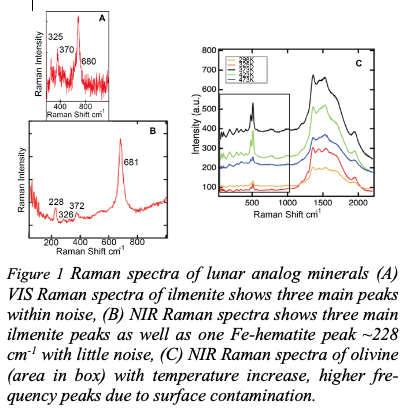Comparative VIS and NIR Raman and FTIR Spectroscopy of Lunar Analog Samples
- 1University of Maryland College Park, Goddard Space Flight Center, Planetary Systems Lab, United States of America (dina.m.bower@nasa.gov)
- 2Howard University, Department of Physics and Astronomy, Washington, DC, 20059, United States of America
- 3St. Olaf College, Department of Physics, Northfield MN, 55057, United States of America
- 4Morehead State University, Department of Math and Physics, Morehead, KY, 40351, United States of America
- 5NASA Goddard Space Flight Center, Greenbelt, MD, 20771 United States of America
- 6Catholic University of America, Department of Physics, Washington, DC, 20064, United States of America
Introduction: The ability to discriminate between different mineral phases in lunar materials is critical in reconstructing the origin and evolution of the moon and understanding its relationship to Earth. Resource identification is also critical to develop a viable long-term lunar exploration program enabling a continued human presence. Mineral-bound metals are important resource targets in regolith and mare basalts [1]. Minerals in lunar basalts and regolith such as ilmenite and pyroxene are known hosts of metals like Cr, Ni, Co, and Mn, and ilmenite in particular has been considered for Fe and O2 extraction [2][3].
Raman spectroscopy non-destructively provides structural information to identify trace compounds and minerals in a matter of seconds. Raman spectroscopy has been used for decades to measure the composition of returned lunar samples and analog materials ([4][5][6] and references therein). Raman measurements can be undertaken with multiple excitation wavelengths, (UV ~244nm, VIS ~532nm, NIR ~785nm, and IR ~1064nm), with advantages to using one excitation wavelength over another. The 532 nm wavelength provides high-energy excitation with good sensitivity and low noise for most materials covering a wide spectral range (~0 – 4000 cm-1). This wide range is essential for the identification of volatiles, in which spectral shift for functional groups like OH occur within ~3000 - 3700 cm-1, and minerals with peak shifts ~100-200 cm-1, such as sulfides, feldspars, and quartz polymorphs. NIR Raman has been shown to exhibit better signal-to-noise, particularly for opaque minerals, like sulfides and oxides, and is the typical wavelength utilized in portable Raman instruments for terrestrial resource prospecting ([7][8]). The two wavelengths used together ensure near-comprehensive identification and accurate characterization of lunar materials suitable for resource extraction.
Materials and Methods: This study looks at a suite of lunar analog mineral samples (olivine, plagioclase, pyroxene, ilmenite, apatite) and relevant terrestrial analog rocks using portable and benchtop VIS (532nm) and NIR (780nm) Raman spectroscopy and Fourier transform infrared spectroscopy for comprehensive characterization of composition. Samples were probed either in tact or as powders at room temperature. A subset of powdered samples was heated (T= 298K, 325K, and 373K) and characterized using NIR Raman to study temperature dependence of Raman spectra.
Initial Results: The mineral samples included in the study were all identifiable using both VIS and NIR Raman spectroscopy, and in some cases the portable instruments performed better than the high-resolution benchtop systems. Basalt and ilmenite samples were better characterized under NIR excitation, while the silicate minerals had a better response under VIS excitation (Fig. 1). FTIR measurements of the silicate minerals were informative, but the opaque nature of ilmenite results in low reflectance under higher wavelengths. For both Raman and FTIR measurements, better results were achieved with the pure minerals in comparison to the rocks composed of multiple minerals. The NIR Raman temperature experiments showed an enhancement of spectral peak intensity for minerals like plagioclase as the temperature increased up to 373K.

Ongoing and Future Work: We have demonstrated that Raman excitation under both VIS and NIR provides useful information to identify lunar minerals of interest to the lunar science community as well as for in situ resource identification, with some advantages for one or the other depending on the target sample. IR (2-16 mm) reflectance spectroscopy is useful for silicates, but opaque minerals like ilmenite require lower wavelengths for identification. Our lab is currently exploring VIS-SWIR reflectance (~0.5 – 2.5 mm as a viable alternative, and further work exploring temperature effects on Raman spectra relevant to the lunar surface is also being done.
Acknowledgements: M. Peterson, M. Howard and P. Misra would like to acknowledge the financial support received from the REU Site in Physics at Howard University (NSF Award # PHY 1659224). D. Bower, S. Li, T. Hewagama, S. Aslam, J. Kolasinski, N. Gorius, T. Livengood, and A. McAdam would like to acknowledge the support of the Internal Research and Development and Fundamental Laboratory Research Programs at Goddard Space Flight Center.
References: [1] Taylor, G. J. and Martel, L. M. V. (2003) Adv. In Sp. Res., 31, 2403-2412. [2] James, O. B. (1973) XX. [3] Papike J., Taylor L., and Simon S. (1991) in Lunar Sourcebook, pg. 121. [4] Wang, A. et al. (2001) American Mineralogist, 86, 790-806. [5] Jolliff, B. et al. (2006) American Mineralogist, 91, 1583-1595. [6] Ling, Z.C. et al. (2011) Icarus, 211,101-113. [7] Jehlicka and Vandenabeele (2015) Journal of Raman Spectroscopy, 46, 927-932. [8] Ando and Garzanti (2014) Geological Society of London Spec. Pub, 386, 395-412.
How to cite: Bower, D., Misra, P., Peterson, M., Howard, M., Hewagama, T., Gorius, N., Li, S., Aslam, S., Livengood, T., McAdam, A., and Kolasinski, J.: Comparative VIS and NIR Raman and FTIR Spectroscopy of Lunar Analog Samples, Europlanet Science Congress 2020, online, 21 Sep–9 Oct 2020, EPSC2020-427, https://doi.org/10.5194/epsc2020-427, 2020.

